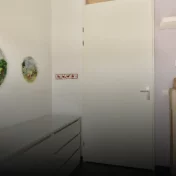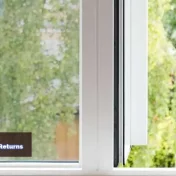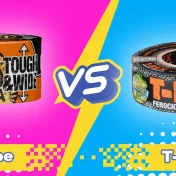Outdoor cushions are an essential part of your patio or garden furniture, adding comfort and style to your outdoor living space.
However, the outdoor environment poses unique challenges, especially when it comes to weather elements like rain, snow, and even morning dew.
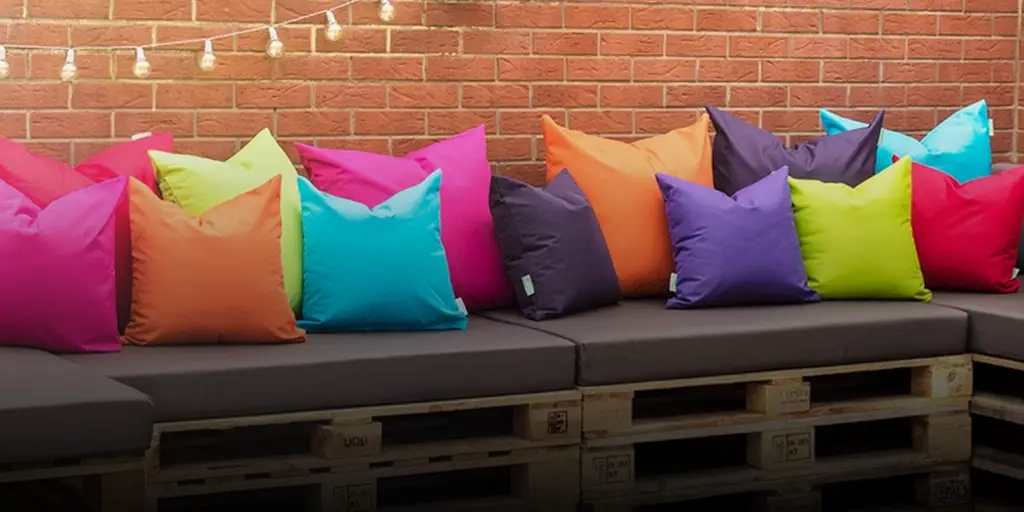
This makes waterproofing your outdoor cushions a crucial step to ensure their longevity and maintain their aesthetic appeal.
Why Waterproofing is Essential:
- Protection from Weather: Unprotected cushions can absorb water, leading to mold, mildew, and a shortened lifespan.
- Enhanced Durability: Waterproof cushions resist wear and tear from weather fluctuations, keeping them looking new for longer.
- Improved Comfort: Nobody enjoys sitting on a soggy cushion! Waterproofing ensures a dry, comfortable seat no matter the weather.
Overview of Waterproofing Methods:
There are several approaches to waterproofing outdoor cushions, each with its unique benefits and considerations. This guide will delve into the most effective methods, including:
- Using waterproof sprays for existing cushions
- Choosing naturally waterproof materials
- Alternative solutions like furniture covers
Understanding the different methods and how to apply them will help you make the best choice for your outdoor cushions, ensuring they remain dry, comfortable, and visually appealing.
Types of Outdoor Cushions
When it comes to outdoor cushions, the material they are made from plays a pivotal role in how well they can withstand the elements.
It’s crucial to understand the different types of materials used in outdoor cushions to make an informed decision about waterproofing.
Common Outdoor Cushion Materials:
Polyester: Widely used due to its durability and affordability. While it’s resistant to some weather conditions, polyester is not inherently waterproof.
Acrylic: Known for its resistance to fading and mildew. Acrylic fabrics are more water-resistant than polyester but still benefit from additional waterproofing.
Olefin: Highly durable and resistant to fading, staining, and mildew. Olefin is more water-resistant than polyester and acrylic but can still benefit from waterproofing treatments.
Pros and Cons of Different Materials:
Polyester:
- Pros: Affordable, durable, available in various colors and patterns.
- Cons: Not naturally waterproof, may fade over time.
Acrylic:
- Pros: Fade-resistant, mildew-resistant, available in vibrant colors.
- Cons: More expensive than polyester, not completely waterproof.
Olefin:
- Pros: Excellent durability, fade and stain-resistant, mildew-resistant.
- Cons: Limited patterns and textures available, higher cost.
Understanding these materials helps in selecting the right type of cushion for your outdoor space and in determining the best waterproofing method to use.
Knowing How to Use Waterproof Materials
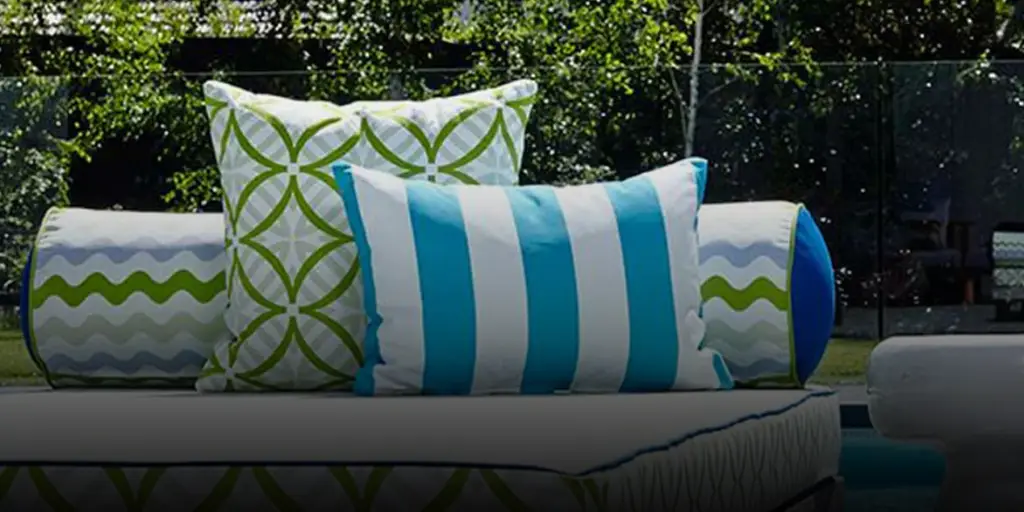
To effectively waterproof outdoor cushions, it’s important to understand what makes a material waterproof and which materials are naturally inclined to repel water.
Characteristics of Waterproof Materials:
- Water Repellency: This is the ability of a material to resist water penetration. Water-repellent fabrics let water bead up and roll off the surface.
- Breathability: Good waterproof materials allow air to pass through, preventing mold and mildew growth by letting the cushion dry out naturally.
Examples of Naturally Waterproof Materials:
- Vinyl: Vinyl covers are inherently waterproof and are a popular choice for outdoor furniture covers.
- Marine-Grade Fabrics: These are designed for use in marine environments and are highly water-resistant.
However, not all outdoor cushions are made from these materials. In such cases, applying waterproof sprays or using protective covers becomes essential to safeguard the cushions.
Waterproof Sprays: A Solution for Non-Waterproof Cushions
For cushions made from materials like polyester, acrylic, or olefin, using a waterproof spray is an effective way to add a layer of water resistance.
These sprays create a protective coating that repels water, safeguarding your cushions against moisture and the elements.
How Waterproof Sprays Work:
- They coat the fibers of the cushion fabric, forming a water-resistant barrier.
- This barrier prevents water from penetrating the fabric, while still allowing it to breathe.
Applying Waterproof Sprays: A Step-by-Step Guide
- Clean the Cushions: Before applying the spray, ensure the cushions are clean and dry.
- Apply in a Well-Ventilated Area: Use the spray outdoors or in a well-ventilated space to avoid inhaling fumes.
- Even Coating: Hold the can 6-8 inches away from the cushion and spray evenly, covering the entire surface.
- Allow to Dry: Let the cushions dry completely before using or storing them.
Tips for Maintaining Effectiveness:
- Reapply the spray periodically, especially after cleaning the cushions.
- Test the spray on a small, inconspicuous area first to ensure it doesn’t affect the fabric’s color or texture.
Using waterproof sprays is a convenient and cost-effective way to protect your outdoor cushions, especially if you’re dealing with non-waterproof materials.
Alternative Waterproofing Solutions
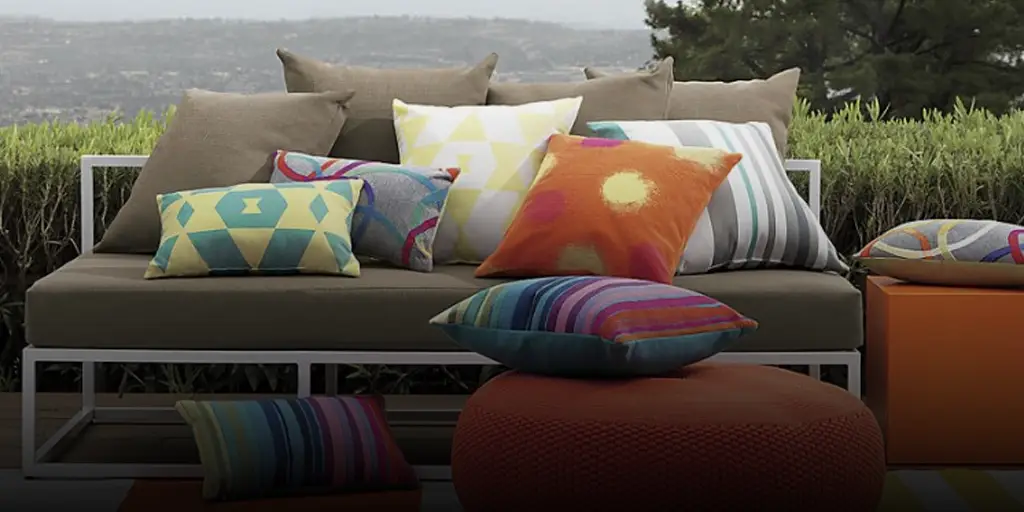
Apart from waterproof sprays, there are other methods to protect your outdoor cushions from water damage.
Using Furniture Covers:
- Purpose: Furniture covers are designed to protect your entire outdoor furniture set, including the cushions.
- Benefits: They offer a comprehensive solution against rain, snow, and even sun damage.
- Selection Tips: Choose covers that are waterproof, breathable, and fit your furniture snugly.
Benefits of Combining Methods:
- Combining waterproof sprays with furniture covers offers double protection, ensuring your cushions stay dry and last longer.
- This dual approach is particularly beneficial in areas with harsh weather conditions.
Other alternatives include storing cushions indoors during bad weather or using waterproof cushion storage boxes.
These methods can significantly extend the life of your cushions and maintain their appearance.
People Who Want to Read This Article: pool stabilizer alternative
Maintenance Tips for Waterproofed Cushions
Proper maintenance is key to ensuring your waterproofed outdoor cushions remain in top condition. Here are some essential tips for keeping your cushions looking great and functioning well:
Cleaning Waterproofed Cushions:
- Routine Cleaning: Use a soft brush and a mild soap solution to gently clean the cushions. Rinse with water and let them air dry.
- Avoid Harsh Chemicals: Harsh cleaning agents can damage the waterproof coating. Stick to mild soaps or specialized fabric cleaners.
Storing Cushions During Off-Seasons:
- Proper Storage: Store cushions in a dry, cool place when not in use, especially during the winter or rainy seasons.
- Use Cushion Bags: Cushion storage bags offer an extra layer of protection against dust and moisture.
Regular Maintenance Tips:
- Inspect Regularly: Check for signs of wear and tear, and reapply waterproofing treatments as needed.
- Sun Exposure: Minimize prolonged exposure to direct sunlight to prevent fading and degradation of the waterproof coating.
By following these maintenance tips, you can prolong the life of your outdoor cushions and ensure they stay comfortable and visually appealing for years to come.
DIY Waterproofing vs. Professional Solutions
When it comes to waterproofing outdoor cushions, homeowners often ponder whether to opt for a DIY approach or seek professional services. Here’s a comparison to help you make an informed decision:
DIY Waterproofing:
- Cost-Effectiveness: Generally more affordable than hiring professionals.
- Flexibility: Allows you to choose the products and methods that best suit your needs.
- Limitations: May not provide as thorough or long-lasting protection as professional services.
Professional Waterproofing Solutions:
- Expertise: Professionals have access to high-quality materials and techniques.
- Durability: Typically offers more durable and long-lasting protection.
- Cost: More expensive than DIY methods, but the investment can be worthwhile for high-quality cushions.
Cost-Benefit Analysis:
- Weigh the cost of professional services against the value of your cushions and your time. For high-end outdoor furniture, professional waterproofing can be a wise investment.
Whether you choose DIY methods or professional services, the key is to ensure your outdoor cushions are adequately protected from the elements.
Conclusion
In conclusion, waterproofing outdoor cushions is an essential step in preserving their quality, comfort, and appearance.
Whether you choose DIY methods, such as waterproof sprays, or professional services, the investment in waterproofing will pay off in the long run.
Remember, regular maintenance and proper storage are key to prolonging the life of your waterproofed cushions.
FAQ Section
How often should I reapply waterproof spray to my cushions?
It’s recommended to reapply waterproof spray at least once a year or more frequently if the cushions are exposed to harsh weather conditions.
Can I waterproof any type of outdoor cushion fabric?
Most outdoor cushion fabrics can be waterproofed, but it’s important to test the spray on a small area first to ensure compatibility.
Are waterproof cushions still comfortable to sit on?
Yes, modern waterproofing methods maintain the comfort and breathability of the cushion fabric.

